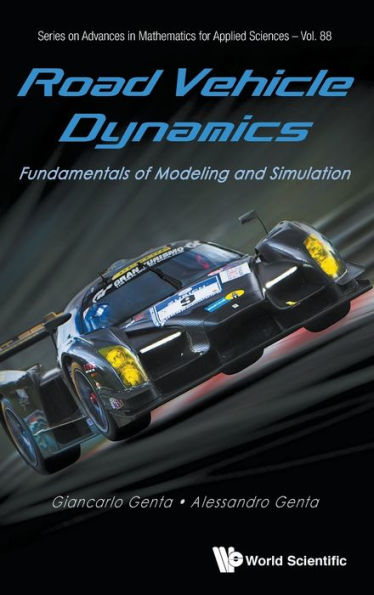Table of Contents
Preface vii
Symbols xix
Acronyms xxv
1 Short Historical Notes on Motor Vehicles 1
1.1 Ground vehicles with mechanical propulsion 1
1.2 Vehicles on wheels from prehistory to the end of the Roman Empire 2
1.3 From the middle ages to the industrial revolution 16
1.4 Motor vehicles in the 19th century 28
1.5 The age of motor cars 41
1.6 A glimpse into the future 45
I Forces Acting on the Vehicle 65
2 The Tire as a Supporting Device 67
2.1 Wheels for road vehicles 67
2.2 Structure of pneumatic tires 69
2.3 Tire reference frame 73
2.4 Contact pressure and stiffness 75
2.5 Rolling radius 79
2.6 Rolling resistance 81
2.7 Dynamic behavior of tires 96
2.8 Experimental study of the characteristics of tires 97
3 Driving, Braking and Cornering Forces 101
3.1 Tractive and braking forces 102
3.2 Cornering forces 111
3.3 Interaction between longitudinal and side forces 124
3.4 Mathematical models for the longitudinal and side forces 128
3.5 Behavior of tires in dynamic conditions 145
4 Road Vehicle Aerodynamics 149
4.1 General considerations 149
4.2 Reference frames 152
4.3 Aerodynamic forces and moments 154
4.4 Aerodynamic field 162
4.5 Aerodynamic drag 170
4.6 Aerodynamic lift and pitching moment 188
4.7 Side force, rolling and yawing moments 194
4.8 Experimental study of aerodynamic forces and moments 198
4.9 Numerical aerodynamics 204
II Dynamics of a Rigid Vehicle 209
5 Longitudinal Steady-State Dynamics 211
5.1 Reference frames for the rigid vehicle 211
5.2 Load distribution on the ground 213
5.3 Total resistance to motion 222
5.4 Characteristics of internal combustion engines 224
5.5 Transmission 229
5.6 Maximum power which can be transferred to the road 232
5.7 Maximum performances allowed by the engine 240
5.8 Fuel consumption at constant speed 245
5.9 Electric and hybrid vehicles 248
6 Longitudinal Dynamics during Acceleration 271
6.1 Non steady-state longitudinal dynamics 271
6.2 Maximum acceleration 274
6.3 Vehicle take-off from rest 280
6.4 Models accounting for the tire slip 287
6.5 Model including the clutch and the tire 290
6.6 Coupling between longitudinal and driveline dynamics 293
6.7 Dynamic model of the engine 307
6.8 Multibody driveline models 337
6.9 Control systems for longitudinal dynamics 338
6.10 Fuel consumption in actual driving conditions 345
7 Braking 355
7.1 Braking in ideal conditions 355
7.2 Braking in actual conditions 360
7.3 Braking power 366
7.4 Antilock systems (ABS) 368
7.5 An outline on standards for braking systems 375
7.6 Global model for longitudinal dynamics 378
8 Steady-State Handling 383
8.1 Trajectory control in road vehicles 383
8.2 Steady-state cornering: geometry 387
8.3 Low-speed or kinematic steering 393
8.4 Simplified model: Ideal steering 399
8.5 High-speed cornering of a rigid vehicle 408
8.6 Linearized handling model 416
8.7 Linearized steady state directional behavior 426
8.8 Slip steering 442
8.9 Influence of longitudinal forces on the handling 444
8.10 Transversal load shift 448
8.11 Toe in 450
8.12 Vehicles with two steering axles (4WS) 451
8.13 Limits of linearized models 455
8.14 Semilinearized models 456
9 Non-Steady-State Handling 463
9.1 Equations of motion for high-speed cornering 463
9.2 Linearized handling model 466
9.3 Spring, mass, damper analogy 470
9.4 Stability of the vehicle 471
9.5 Unstationary motion 485
9.6 Steering response in dynamic conditions 491
9.7 Handling control system 495
9.8 Vehicle-driver interaction 504
10 Vehicles with Trailers 521
10.1 Kinematic steering of vehicles with trailer 521
10.2 Simplified dynamic trailer models 529
10.3 Model with 4 degrees of freedom for articulated vehicles 538
10.4 Linearized model for articulated vehicles 547
10.5 Multibody articulated vehicles 563
III Dynamics of a Vehicle on Elastic Suspensions 575
11 Noise, Vibration, Harshness (NVH) 577
11.1 Causes for vibrations affecting motor vehicles 577
11.2 Internal excitation 578
11.3 Road excitation 585
11.4 Effects of vibration on the human body 589
12 Types of Suspensions 593
12.1 Motor vehicle on elastic suspensions 593
12.2 Solid-axle suspensions 596
12.3 Independent-wheels suspensions 603
12.4 Twist beam suspension 619
12.5 Camber recovery 624
12.6 Anti-dive and anti-squat designs 625
12.7 Active suspensions 630
13 Simple Suspension Models 633
13.1 Quarter-car models 633
13.2 Quarter-car with a single degree of freedom 634
13.3 Quarter-car with two degrees of freedom 646
13.4 International roughness index 655
13.5 Quarter-car with secondary suspension (three degrees of freedom) 656
13.6 Quarter-car model with dynamic vibration absorber 659
13.7 Quarter-car model with J-damper 662
13.8 Quarter-car with many degrees of freedom to study the suspension-tire interaction 667
13.9 Effect of the suspension kinematics 674
13.10 Heave and pitch motions 682
13.11 Roll motion 707
13.12 Concluding remarks on ride comfort 712
13.13 Active suspensions 717
14 Multibody Models 749
14.1 Models for motor vehicles 749
14.2 Isolated vehicle 756
14.3 Linearized model for the isolated vehicle 759
14.4 Model with 10 degrees of freedom with locked controls 796
14.5 Handling of a vehicle on elastic suspensions 818
14.6 Ride comfort 823
14.7 Conclusions on the linearized models made of rigid bodies 828
14.8 Models of deformable vehicles 829
14.9 Articulated vehicles 839
14.10 Gyroscopic moments and other second order effects 840
14.11 Simple model for the handling of motorcycles 844
15 Models for Studying Road Accidents 885
15.1 Road safety 885
15.2 Vehicle collision: Impulsive model 889
15.3 Vehicle collision: Advanced model 906
15.4 Motion after the collision 922
15.5 Rollover 931
15.6 Motion of transported objects during the impact 943
References 953
Index 957



